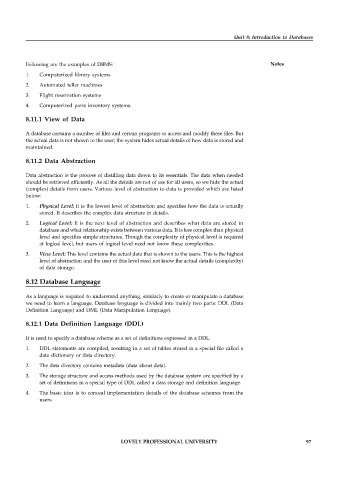Page 103 - DCAP516_COMPUTER_SECURITY
P. 103
Unit 8: Introduction to Databases
Following are the examples of DBMS: Notes
1. Computerized library systems
2. Automated teller machines
3. Flight reservation systems
4. Computerized parts inventory systems.
8.11.1 View of Data
A database contains a number of files and certain programs to access and modify these files. But
the actual data is not shown to the user; the system hides actual details of how data is stored and
maintained.
8.11.2 Data Abstraction
Data abstraction is the process of distilling data down to its essentials. The data when needed
should be retrieved efficiently. As all the details are not of use for all users, so we hide the actual
(complex) details from users. Various level of abstraction to data is provided which are listed
below:
1. Physical Level: It is the lowest level of abstraction and specifies how the data is actually
stored. It describes the complex data structure in details.
2. Logical Level: It is the next level of abstraction and describes what data are stored in
database and what relationship exists between various data. It is less complex than physical
level and specifies simple structures. Though the complexity of physical level is required
at logical level, but users of logical level need not know these complexities.
3. View Level: This level contains the actual data that is shown to the users. This is the highest
level of abstraction and the user of this level need not know the actual details (complexity)
of data storage.
8.12 Database Language
As a language is required to understand anything, similarly to create or manipulate a database
we need to learn a language. Database language is divided into mainly two parts: DDL (Data
Definition Language) and DML (Data Manipulation Language).
8.12.1 Data Definition Language (DDL)
It is used to specify a database scheme as a set of definitions expressed in a DDL.
1. DDL statements are compiled, resulting in a set of tables stored in a special file called a
data dictionary or data directory.
2. The data directory contains metadata (data about data).
3. The storage structure and access methods used by the database system are specified by a
set of definitions in a special type of DDL called a data storage and definition language.
4. The basic idea is to conceal implementation details of the database schemes from the
users.
LOVELY PROFESSIONAL UNIVERSITY 97

